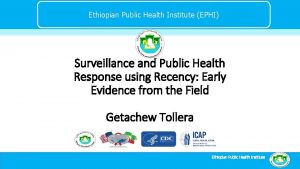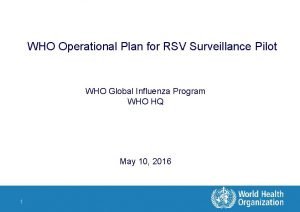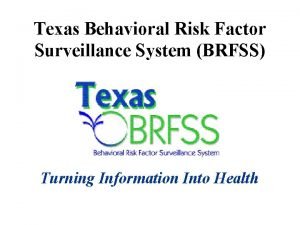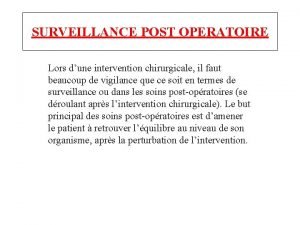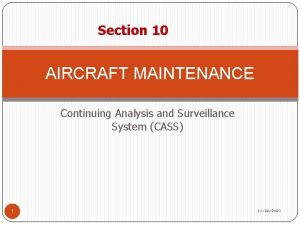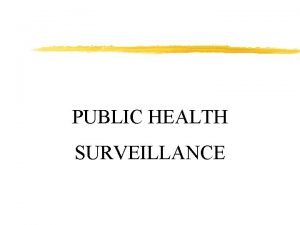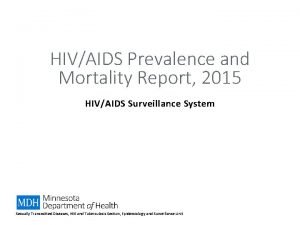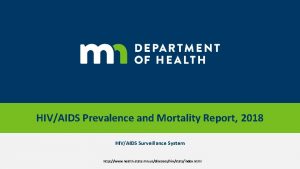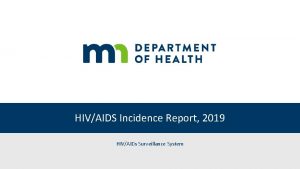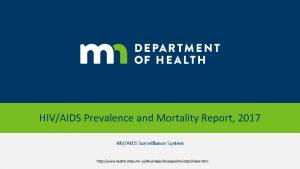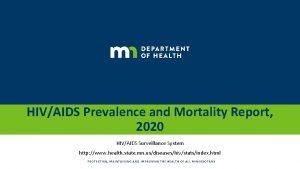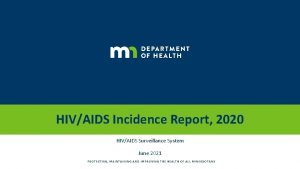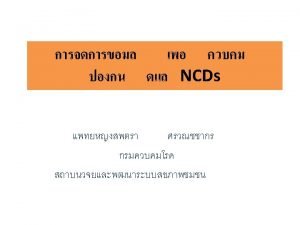Components of HIVAIDS Case Surveillance Case Report Forms
























- Slides: 24

Components of HIV/AIDS Case Surveillance: Case Report Forms and Sources

Developing a Case Report Form In developing a Case Report Form, One Must: Select the WHO surveillance case definition to be used in the country Determine the clinical events to be captured Select the unique identifier or set of identifiers

WHO Case Definition: HIV Infection HIV infection surveillance includes reports of all persons with HIV infection, regardless of clinical stage Persons should be reported if they: Are newly diagnosed regardless of clinical stage Were previously diagnosed but not previously reported Were previously diagnosed and reported at clinical stage 1 or 2 and progressed to stage 3 or 4 The report should include the clinical stage at diagnosis

HIV Case Reporting Data Outputs The distribution of patient demographic and risk characteristics Capture the spectrum of key events in course of HIV disease Monitor levels of and trends in: Diagnosis of HIV (infection or advanced infection) Clinical stage at time of diagnosis Use of ART and prophylaxis HIV- and non-HIV-related deaths Development and types of opportunistic illness Time between most recent negative HIV test and diagnosis

Function of the HIV Case Report Form The case report form is used to standardise the collection of information that is obtained on all reported HIV cases An HIV case report form is designed to: Collect information that promotes understanding of HIV infection, morbidity, and mortality Facilitate reporting an HIV case Standardise the collection of variables

HIV Case Report Form Links Surveillance Inputs to Outputs Inputs • Sources • Reporters Case Report Form Outputs • Data for public health action

Developing the Case Report Form A case report form should be designed with the following in mind: The feasibility of completing the form The need for reporting to be complete The current and future needs of case reporting data Maintaining the integrity of the reporting system The acceptability of the form to persons responsible for submitting reports The overall simplicity of the form

Factors to Consider in Designing the Case Report Form Availability of data Consistency of data collected from the reporting sources Validity of data Sources of reports Persons completing the form Minimizing burden to staff completing the form

Ensuring Quality Data Case report forms must be completed correctly and in a timely fashion Persons reporting cases must: Have forms readily available Know how to complete the form Have instructions included with the form Include information on who to call with questions and where form should be submitted

Elements of a Case Report Form A comprehensive case report form contains: Reporting source information Individual reporting the case Facility from which case is reported Date of report

Elements of a Case Report Form continued Patient information Personal identifier (e. g. name) Date of diagnosis Demographic and risk characteristics Vital status HIV testing HIV clinical stage and immunologic status at diagnosis and progression from stages 1 or 2 to advanced HIV infection Treatment and care

Patient Identifier, Demographic, and Vital Status Information

HIV Risk Character Information

HIV Clinical Stage, Immunologic Information, and HIV Testing History

Identifying Reporting Sources LOCATION WHERE VCT Site • VCT Counseling and Testing Form • • Administrative information Demographic information Behavioural risk factors Diagnosis information Hospitals/Health Care Clinics • Client medical record • • Administrative information Demographic information Diagnosis information Behavioral risk factors PMTCT/ANC Clinics • • ANC register PMTCT register Client medical record • • Administrative information Demographic information Diagnosis information Vital status Client medical record • • Administrative information Demographic information Diagnosis information Behavioral risk factors • ART Clinics • WHAT DATA • • • Clinical stage Opportunistic illnesses Immunologic status Care and treatment Vital status

Identifying Reporting Sources LOCATION WHERE Laboratories • • • Laboratory Test Request Forms Laboratory Result Forms Laboratory Registers • Client Medical Record • • TB Clinics WHAT DATA • • • Administrative information Demographic information Diagnosis information • • Clinical stage Immunologic status Administrative information Demographic information • • Diagnosis information Vital status Vital Statistics Registries • Vital statistic registry/database • • Vital status Cause of Death Mobile/Outreach • Counseling and Testing Forms Outreach data collection forms • Administrative information Demographic information • • Behavioural risk factors Diagnosis information Client Medical Record • Administrative information Demographic information Diagnosis information • • Clinical stage Immunologic status Care and treatment Vital status • Private Doctors • •

Multiple Data Sources, One Case HOSPTIAL/ ART CLINIC VCT CENTRE (name, sex, dob, residence, date (name, sex, dob, behavioral, residence, date of dx, facility of dx) VITAL STATISTICS REGISTRY (name, sex, dob, residence, date of death, cause of death) of dx, facility of dx, art start date, prophylaxis, clinical staging, behavioural, vital status, VL, CD 4) PRIVATE PHYSICIANS HIV CASE REPORTING DATABASE PMTCT CLINIC (name, sex, dob, residence, date of dx, facility of dx, art start date, prophylaxis, clinical staging, vital status, VL, CD 4) (name, sex, dob, residence, date of dx, facility of dx, art start date, prophylaxis, clinical staging, behavioural vital status, VL, CD 4) LABORATORY (name, sex, dob, date of dx, VL and CD 4 near or at dx)

The Need for a Unique Case Identifier HIV case-based reporting is unique among infectious disease surveillance systems because: A person can acquire HIV only once A person is diagnosed and reported with advanced HIV infection only once Even if clinical status improves, cases should be reported only at: Initial diagnosis of stage 1 or 2 infection Initial diagnosis of stage 3 or 4 infection

The Need for a Unique Case Identifier, continued In order to accurately measure the level of and trends in disease burden surveillance programmes must identify duplicate cases and retain the report with the earliest date of diagnosis A longitudinal surveillance database requires Following reported cases over time Identifying progression from stages 1 and 2 to advanced HIV infection Updating a patient record when additional data are obtained

Selecting A Case Identifier The case identifier must: Be unique to the individual Not change over time or allow time of change to be known Be easy to identify from a clinical record Be something that is or is derived from routinely collected data The case identifier must be able to: Distinguish duplicate reports for the same person Distinguish cases with the identifier who are different persons Allow follow-up information from the surveillance programme and healthcare provider to be easily connected with existing information

Selecting A Case Identifier, continued The identifier must: Be available without interviewing the patient Allow evaluation of the surveillance system: Permit assessing the completeness and timeliness of reporting Permit assessing validity of data on case report forms Be evaluated

Mandatory Variables for Counting Cases Only cases that meet the WHO HIV infection or advanced HIV infection surveillance case definitions should be reported Required on the case report form for the surveillance programme to count a case are: Case identifier (name or code) Sex Date of birth Earliest date of diagnosis Clinical stage and/or CD 4 test result Date of death (if applicable)

Summary HIV infection reporting: Provides data on number and characteristics of persons with HIV and advanced HIV Is used to determine current and future needs for ART and prevention programmes and to assess their impact Countries should begin HIV reporting by: Identifying reporting sites, staff and resources Adopting the surveillance case definition Determining who will be responsible for case reporting Determine desired outputs Develop a case report form with these factors taken into consideration

Thank You Working Together to Plan, Implement, and Use HIV Surveillance Systems
 Hiv case-based surveillance in ethiopia
Hiv case-based surveillance in ethiopia Best case worst case average case
Best case worst case average case Gathering performance information
Gathering performance information Why are related forms more agreeable than unrelated forms?
Why are related forms more agreeable than unrelated forms? Were contracted form
Were contracted form Why are related forms more agreeable than unrelated forms
Why are related forms more agreeable than unrelated forms Why are related forms more agreeable than unrelated forms?
Why are related forms more agreeable than unrelated forms? Strong forms
Strong forms Elements of report writing
Elements of report writing Difference between status report and progress report
Difference between status report and progress report What is partial report technique
What is partial report technique Who rsv surveillance
Who rsv surveillance Texas brfss
Texas brfss Surveillance postopératoire
Surveillance postopératoire Types of surveillance
Types of surveillance Fixateur externe douleur
Fixateur externe douleur Continuous analysis and surveillance system
Continuous analysis and surveillance system Reconnaissance and surveillance leaders course
Reconnaissance and surveillance leaders course Nav canada cfps
Nav canada cfps Sentinel surveillance is for
Sentinel surveillance is for Pss surveillance
Pss surveillance Drain de kehr soins infirmiers
Drain de kehr soins infirmiers Surveillance photos
Surveillance photos Passive surveillance
Passive surveillance Redons aspiratifs
Redons aspiratifs
